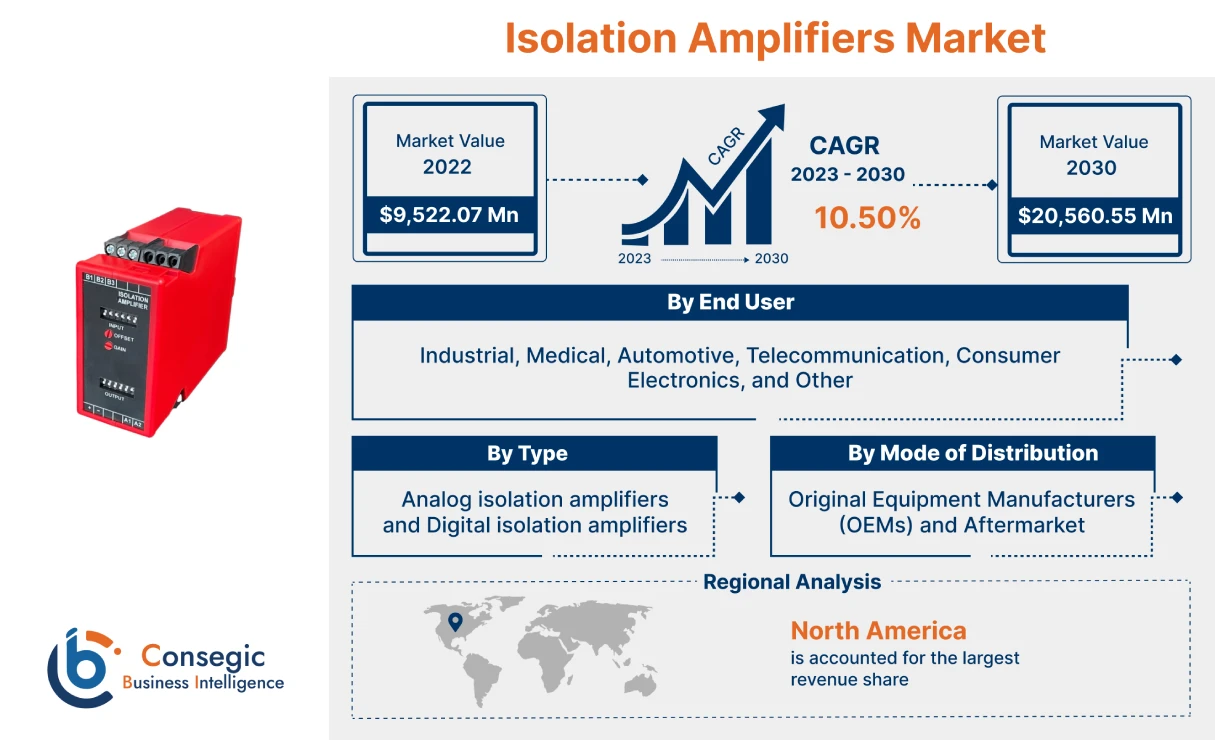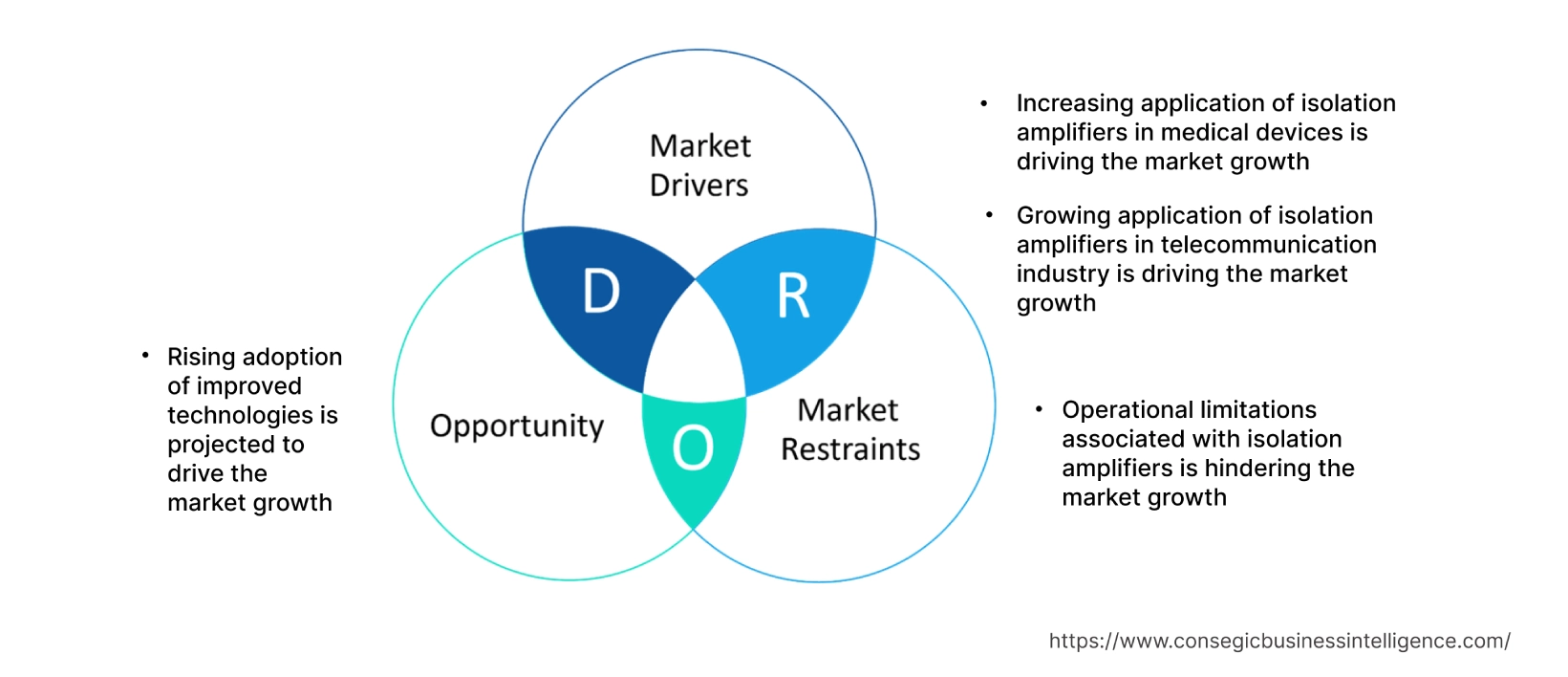Isolation Amplifiers Market Size :
Isolation Amplifiers Market size is estimated to reach over USD 20,560.55 Million by 2030 from a value of USD 9,522.07 Million in 2022, growing at a CAGR of 10.50% from 2023 to 2030.
Isolation Amplifiers Market Scope & Overview:
Isolation amplifiers are devices that separate electrical circuits of input and output terminals of the amplifier. In addition, an isolation amplifier is utilized to provide Ohmic isolation and employed to amplify low-level signals. Moreover, isolation amplifiers are used to separate a certain section of a circuit from another. Accordingly, isolation amplifiers help to reduce the wastage of power during its transfer in the circuit and allows the voltage to remain constant throughout the process of transfer, be it the input or output voltage.
Further, key applications of isolation amplifiers include elimination of ground loop in industries, power isolation in nuclear plants, monitoring of patients and diagnostic functions in healthcare sector.
Isolation Amplifiers Market Insights :
Isolation Amplifiers Market Dynamics - (DRO) :
Key Drivers :
Increasing application of isolation amplifiers in medical devices is driving the market growth
Isolation amplifiers in the healthcare sector, specifically in medical devices is considered to have utmost importance. Accordingly, isolation amplifiers are employed in a variety of devices including EEG (Electroencephalography), ECG (Electrocardiography) monitors and infusion pumps. The key factors attributing to the growth of isolation amplifiers in devices such as EEG and ECG monitors is due to rising demand for clinical diagnostic tools to monitor cardiac and abnormal brain beats among patients. Moreover, isolation amplifiers help patients by protecting them from coming in contact with electrical shock and other hazards. Furthermore, the devices allow to improve the accuracy of measurements.
For instance, isolation amplifiers in the form of electroencephalogram amplifier, launched by BIOPAC Systems Inc. has advanced research applications in the field of neuronal studies. The product namely, EEG100C electroencephalogram amplifier is designed to amplify the bioelectric potentials of brain connected with neural network which perform bipolar or unipolar measurements.
Furthermore, application of isolation amplifiers in important medical devices that interface with the nervous system, such as deep brain stimulation (DBS) devices for Parkinson's disease are increasingly popular within the healthcare sector. DBS devices are implanted in the brain to deliver electrical pulses to specific areas of the brain. The pulses are used to modulate the activity of neurons in these areas, which help to reduce the symptoms of Parkinson's disease, such as tremor, rigidity, and slowness of movement.
According to World Health Organization, there has been a rising numbers of cases for Parkinson's disease in last few years. The numbers of Parkinson's disease in the year 2019 was accounted to surpassed 8.5 million resulting in the rise in number of Disability Adjusted Life Years (DALYs) 5.8 by 81% with respect to the year 2000. Therefore, with the rise in numbers of neural diseases and increasing efforts to curb the same at global level is promoting the demand for isolation amplifier-based devices.
Growing application of isolation amplifiers in telecommunication industry is driving the market growth
Isolation amplifiers have an important application in the field of telecommunication, including prevention of signal interference and cross communication among network subscribers. In addition, these devices help in securing the data transmission thus improving data security. The key factors attributing to the growth of isolation amplifiers in telecommunication sector include prevention of sensitive signals from noise. Moreover, devices including receiver, transmitters, and data lines are different devices inline to form a set of communication, thus it is necessary to prevent aforementioned devices from signal interference caused due to generation of noise.
Additionally, with the growing demand for proper communication networks including implementation of 5G connectivity is promoting the growth of telecommunication sector. Isolation amplifiers thus help in improving the reliability of communication network by preventing signal interference among connected devices. Therefore, owing to rising demand for proper telecommunication infrastructure has been propelling the isolation amplifiers market trends.
Key Restraints :
Operational limitations associated with isolation amplifiers is hindering the market growth
Isolation amplifiers have few of the technical limitations including cost of installation, complex nature of design, leakage of current, frequency response, among others. One of the factors including high cost of installation typically ranging more than non-isolated amplifiers, due to requirement of additional circuitry to provide isolation known to be hindering the market growth. In addition, the complex nature of design and troubleshoot issues associated with the devices tends to be restraining the market growth.
Furthermore, a few other technical issues such as delayed response frequency due to inability to amplify signals at high frequencies is also accounted to hampering the market growth.
Future Opportunities :
Rising adoption of improved technologies is projected to drive the market growth
The introduction of new technologies has been playing an important role in the growth of isolation amplifiers. Increasing trends including adoption of Industry 4.0 and Internet of Things (IoT) have been propelling the demand for devices that are able to transmit sensitive data over a longer distance. Also, the rising requirement of interference and noise free transmitted data tends to be fuelling the demand for isolation amplifiers. Furthermore, large scale deployment of 5G network across the globe for providing better internet connectivity will promote the growth of isolation amplifiers for signal and noise reduction coupled with protection of personnel and equipment from electrical shock.
Global Isolation Amplifiers Market Report Insights :
| Report Attributes | Report Details |
| Study Timeline | 2017-2030 |
| Market Size in 2030 | USD 20,560.55 Million |
| CAGR (2023-2030) | 10.50% |
| By Type | Analog isolation amplifiers and Digital isolation amplifiers |
| By Mode of Distribution | Original Equipment Manufacturers (OEMs) and Aftermarket |
| By End User | Industrial, Medical, Automotive, Telecommunication, Consumer Electronics, and Other |
| By Region | North America, Europe, Asia-Pacific, Latin America, and Middle East & Africa |
| Key Players | Arrow Electronics, Inc., Analog Devices, Inc., Broadcom Pte Ltd., Texas Instruments Incorporated, NXP Semiconductors, Rockwell Automation, Siemens, ABB, Dewetron GmbH, Silicon Laboratories, Inc., DRAGO Automation GmbH, Toshiba Electronic Devices & Storage Corporation, Renesas Electronics Corporation, ROHM Co., Ltd. |
| Geographies Covered | |
| North America | U.S. Canada Mexico |
| Europe | U.K. Germany France Spain Italy Russia Benelux Rest of Europe |
| APAC | China South Korea Japan India Australia ASEAN Rest of Asia-Pacific |
| Middle East and Africa | GCC Turkey South Africa Rest of MEA |
| LATAM | Brazil Argentina Chile Rest of LATAM |
| Report Coverage | Revenue Forecast, Competitive Landscape, Growth Factors, Restraint or Challenges, Opportunities, Environment & Regulatory Landscape, PESTLE Analysis, PORTER Analysis, Key Technology Landscape, Value Chain Analysis, Cost Analysis, and Regional Trends & Forecast |
Isolation Amplifiers Market Segmental Analysis :
By Type :
Based on the type, the market is bifurcated into analog isolation amplifiers and digital isolation amplifiers. The analog isolation amplifiers segment accounted for the largest revenue share in the year 2022. Analog isolation amplifiers are employed to amplify analog signals. In addition, analog isolation amplifiers apply the use of optocouplers to transmit signals between two circuits. Thus, optocouplers operate by converting input signals into light and transmitting them to output circuit which is further converted into electrical signals for further processing. Analog isolation amplifiers have applications in the region of high-fidelity analog signals isolation including industrial control systems and medical devices.
For instance, Wieland Electric GmbH is offering analog isolation amplifiers, namely of Core series, i.e., cores C1 UI-B, cores C1 PT-B, cores C1 TC-B, cores C2 UI-A, and others have features including high isolation voltage of 1500 V AC, universal functions settable, wide temperature range, among others. Moreover, these devices have high accuracy during digital conversion, thus, proliferating the market growth of analog isolation amplifier segment in the overall isolation amplifiers market.
The Digital isolation amplifiers segment is anticipated to grow at the fastest growth rate during the forecast period. The growth factors are attributed to increasing demand for superior performance of isolation amplifiers in terms of bandwidth and noise. Moreover, digital isolation amplifiers use isolation barrier to transmit signals between the two circuits by means of magnetic coupling. Digital isolation amplifiers are typically employed for applications where digital signals need to be isolated, such as in telecommunications and networking equipment. Thus, owing to the rise in the communication sector in the near future for better network connectivity is projected to drive the market growth of digital isolation amplifiers during the forecast period.
By Mode of Distribution :
Based on the mode of distribution, the market is segmented into original equipment manufacturers (OEMs) and aftermarket. Original equipment manufacturers (OEMs) segment is accounted to generate largest market share in the year 2022. OEMs are the companies that design and manufacture products, including medical equipment, industrial control systems, and telecommunications equipment. They typically purchase isolation amplifiers from specialized suppliers. The key OEMs in the isolation amplifier market include Texas Instruments Incorporated, Analog Devices, Inc., Siemens, among others.
Moreover, the segment is also projected to grow at the fastest CAGR during the forecast period. OEMs play an important role in fulfilling the industrial demand and are thus key designer, integrator, tester for the products. Furthermore, owing to the increasing use of digital technology in commercial and industrial applications is expected to promote Isolation amplifiers market growth during the forecast period.
By End-User :
Based on the end user, the market is segmented into industrial, medical, automotive, telecommunication, consumer electronics, and other. The industrial segment is accounted to generate largest Isolation amplifiers market share of 35.4% in the year 2022. The key factors attributed to the growth of the segment owing to rising demand for process control, safety of systems, remote monitoring, among others. Isolation amplifiers are used to isolate sensors and actuators from the control system. Thus, isolation amplifiers help to protect the control system from electrical noise and interference along with protecting components from higher voltage and amplify low level signals in application with multiple channels.
Furthermore, the telecommunications segment is expected to grow at the fastest growth rate during the forecast period. Owing to rising adoption of 5G connectivity across the globe and demand for safety of systems to isolate sensors and actuators from the power supply. Also, prevention of electrical shocks and other hazards is prompting isolation amplifiers market demand in telecommunication sector.
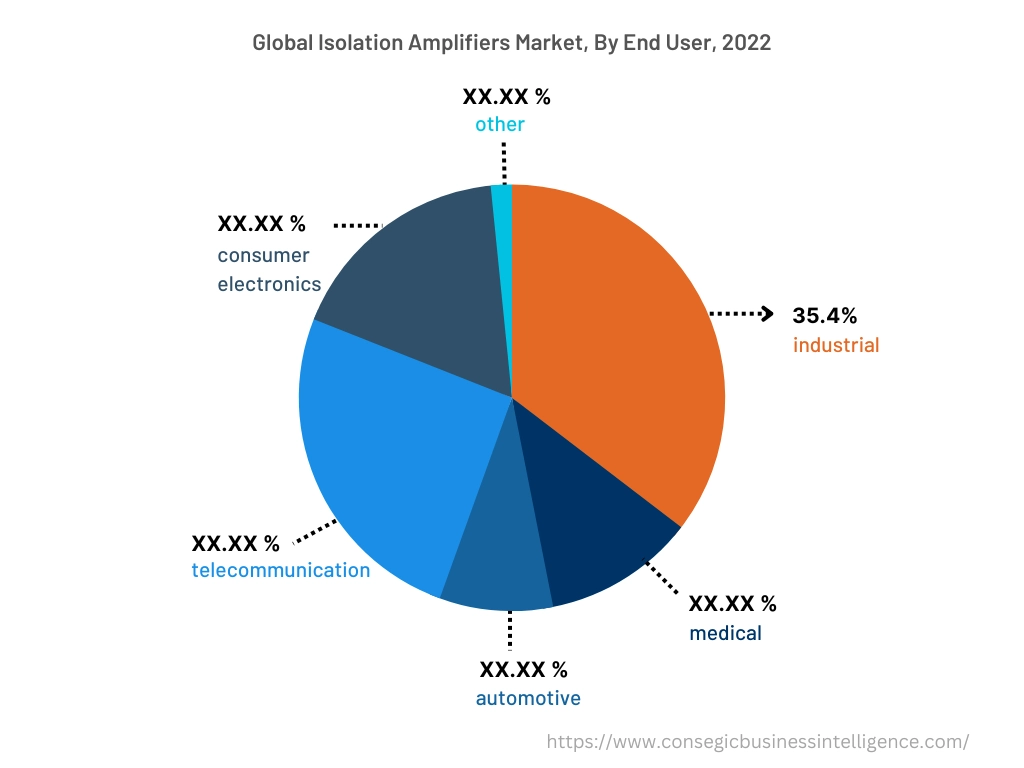
By Region :
The regional segment includes North America, Europe, Asia Pacific, Middle East and Africa, and Latin America.
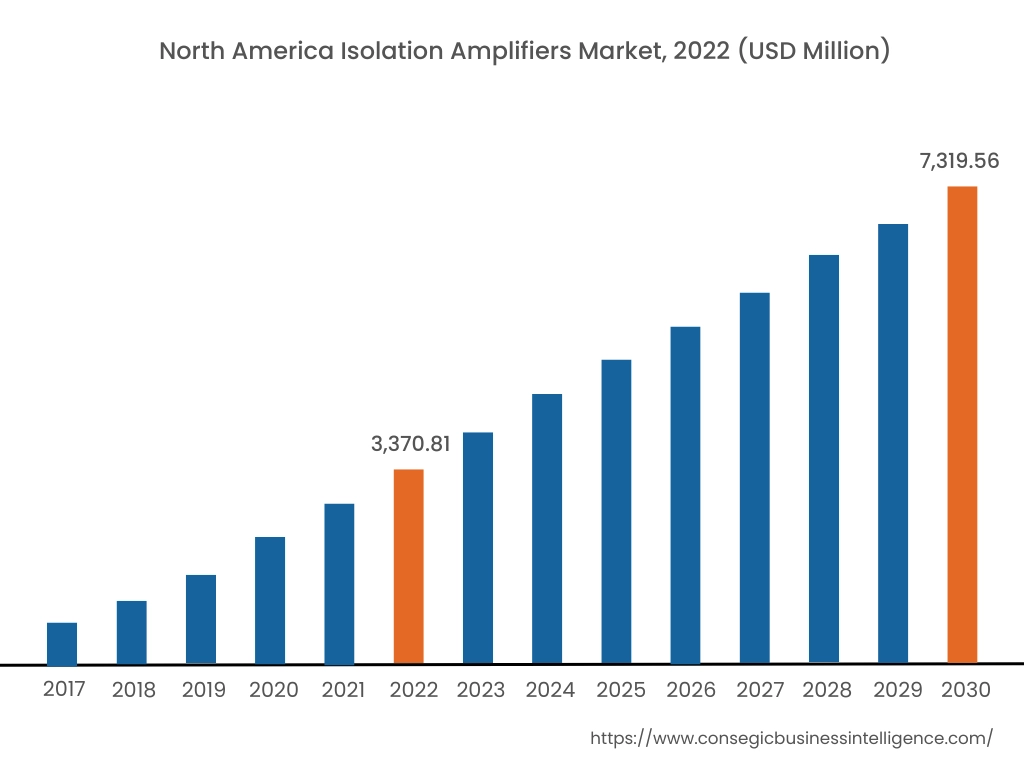
North America is accounted for the largest revenue share of USD 3,370.81 Million in 2022 and is expected to reach USD 7,319.56 Million by 2030. In addition, in the region, the U.S. accounted for the maximum revenue share of 58.5% in the same year. The adoption of isolation amplifiers in North American region is primarily driven by factors including rapid urbanization, well stablished industries, safety rules and regulations, and adoption of new technologies. North America has a well-established telecommunications industry, which is a major user of isolation amplifiers. Isolation amplifiers are used in telecommunications equipment to isolate circuits from each other, which helps to prevent crosstalk and other interference. In addition, North America is an early adopter of new technologies, including cloud computing and big data. Accordingly, the existence of the latest technologies is driving the demand for isolation amplifiers in applications such as data acquisition and signal processing.
Moreover, Asia-Pacific is expected to register the fastest CAGR growth of 10.8% during the forecast period. Factors attributable to the growth of the region during the forecast period are due to rapid economic growth, increasing adoption of technologies, increasing investment in infrastructure, and rising population. Asia Pacific is one of the fastest growing regions in the world, and this is driving the demand for isolation amplifiers in a variety of industries, such as telecommunications, industrial automation, and medical. Also, Asia Pacific is an early adopter of new technologies, including 5G, cloud computing, and artificial intelligence. These technologies are driving the demand for isolation amplifiers in applications such as data acquisition and signal processing. Furthermore, the region has the largest population in the world, and this is driving the demand for isolation amplifiers in applications including healthcare, telecommunication, automotive, consumer electronics, and others.
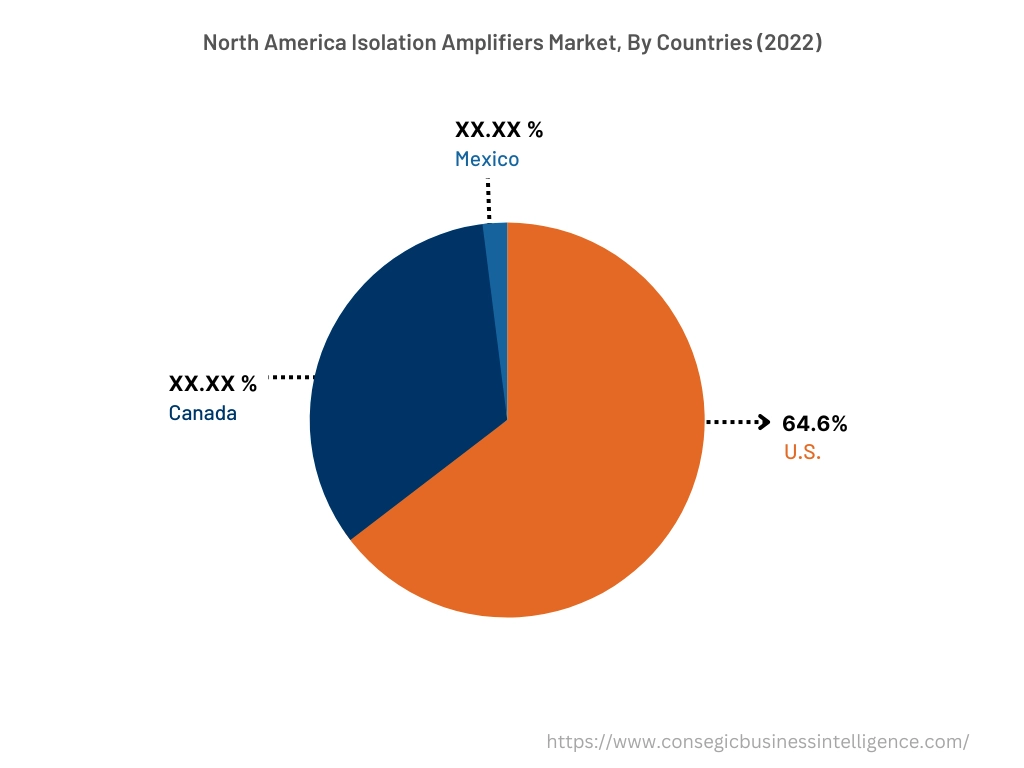
Top Key Players & Market Share Insights:
The isolation amplifiers market is highly competitive with major players providing Isolation Amplifiers to the national and international markets. Key players are adopting several strategies in research and development (R&D), product innovation, and end user launches to hold a strong position in isolation amplifiers market. Key players in the isolation amplifiers market include-
- Arrow Electronics, Inc.
- Analog Devices, Inc.
- Silicon Laboratories, Inc.
- DRAGO Automation GmbH
- Toshiba Electronic Devices & Storage Corporation
- Renesas Electronics Corporation
- ROHM Co., Ltd.
- Broadcom Pte Ltd.
- Texas Instruments Incorporated
- NXP Semiconductors
- Rockwell Automation
- Siemens
- ABB
- Dewetron GmbH
Recent Industry Developments :
- In April 2023, Guerrilla RF launched GaAs pHEMT amplifiers, namely RF2010 and GRF2011. Both are high linearity amplifiers targeted for applications including automotive telematics, 5G/4G base stations, and cellular repeaters/DAS.
- In August 2023, Apex Microtechnology launched power operational amplifier namely PA198.
Key Questions Answered in the Report
What is Isolation Amplifiers? +
Isolation amplifiers is a device that separate electrical circuits of input and output terminals of the amplifier. In addition, isolation amplifier is utilized to provide Ohmic isolation and employed to amplify low-level signals.
What specific segmentation details are covered in the isolation amplifiers report, and how is the dominating segment impacting the market growth? +
For instance, by type segment has witnessed analog Isolation amplifiers as the dominating segment in the year 2022, owing to its increasing demand from industries including automotive, telecommunication, and others.
What specific segmentation details are covered in the isolation amplifiers market report, and how is the fastest segment anticipated to impact the market growth? +
For instance, by end user segment has witnessed telecommunication segment to grow at the fastest growth rate during the forecast period. The rising demand for improved telecommunication infrastructure is expected to boost the market growth during the forecast period.
Which region/country is anticipated to witness the highest CAGR during the forecast period, 2023-2030? +
Asia-Pacific is anticipated to register fastest CAGR growth of 10.8% during the forecast period due to rapid pace of industrialization and demand for improved telecommunication infrastructure.
